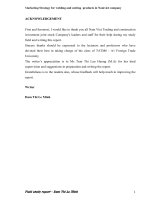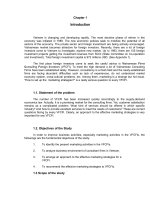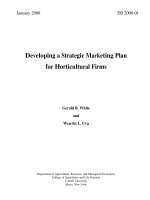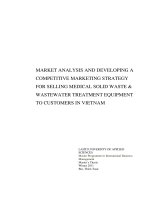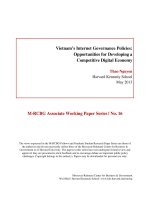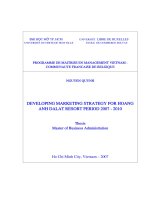Market analysis and developing a competitive marketing strategy for selling medical solid waste wastewater treatment equipment to customers in vietnam
Bạn đang xem bản rút gọn của tài liệu. Xem và tải ngay bản đầy đủ của tài liệu tại đây (4.3 MB, 254 trang )
MARKET ANALYSIS AND DEVELOPING A
COMPETITIVE MARKETING STRATEGY
FOR SELLING MEDICAL SOLID WASTE &
WASTEWATER TREATMENT EQUIPMENT
TO CUSTOMERS IN VIETNAM
LAHTI UNIVERSITY OF APPLIED
SCIENCES
Master Programme in International Business
Management
Master‘s Thesis
Winter 2011
Bui, Thien Toan
Lahti University of Applied Sciences
Master Programme in International Business Management
BUI, THIEN TOAN
Market Analysis and Developing a Competitive Marketing Strategy for Selling Medical Solid Waste and
Wastewater Treatment Equipment to Customers in
Vietnam
Master‘s Thesis, 156 pages and 8 appendices
Winter 2011
ABSTRACT
When sustainable development increasingly becomes the global trend, it is also
the time that the developing world really demands for cleantech solutions from the
western countries to resolve environmental problems it is encountering. In the
writer‘s opinion, this is not just the supply-demand relation following the market
principle purely, but for common benefits of human beings in our planet as well.
From that perspective and in the hope that Vietnam will be prevented from dangerous infectious diseases, as well as environmental damages caused by hazardous hospital waste, this research has been conducted with respect to two research
problems: 1. What is the market demand for hospital waste treatment solutions in
Vietnam? 2. How can a western hospital waste treatment product manufacturer
sell their products to customers in Vietnam successfully?
In order to get the research objectives done, the inductive approach and mixed
methods research design are chosen. Theoretical discussions are associated with
marketing management, competitive analysis, risk and stakeholder management,
market entry mode and the Canvas business model. The empirical research has
been carried out in 3 central cities and 9 provinces in the southern half of Vietnam. The primary data is collected through semi-structure and in-depth interviews
with key stakeholders involved in this business in Vietnam.
The research results have shown that there is really urgent and large demand for
hazardous medical solid waste and wastewater treatment equipment in Vietnam
marketplace. Plus, the Vietnamese Ministry of Health just took a loan of $150
million for a nationwide hospital waste management and treatment performance
improvement project from World Bank in 2011. This project is intended to be
undertaken between 2011 and 2017 in accordance with the agreement between
this ministry and the lender.
As a result, the market entry mode under the form of direct export to two local
distributors, the detailed business model and the competitive marketing strategy
have been proposed to the western hospital waste treatment products manufacturers.
Key words: healthcare, hospital, medical solid waste, medical wastewater, incinerator, CITENCO, DNURENCO, AIC, competitive, marketing strategy
CONTENTS
1
1
1.1
Research background
1
1.2
Research objectives, questions and limitations
4
1.3
Theoretical discussion
6
1.4
Research approach, methodologies and empirical research
7
1.5
2
INTRODUCTION
Research structure
9
THEORETICAL DISCUSSION
11
2.1
Macro environment scan
12
2.2
B2B market environment
14
2.3
Segmenting and targeting B2B markets
24
2.4
Competitor analysis
34
2.5
Stakeholder and risk management
38
2.6
Foreign market entry
38
2.7
Canvas business model
40
2.8
Competitive advantage and marketing mix
42
2.9
Theoretical discussion summary
49
3
RESEARCH APPROACH AND METHODS
50
4
ANALYZING EMPIRICAL RESEARCH DATA
54
4.1
Market analysis
54
4.1.1
Macro environment analysis
54
4.1.2
Vietnam health system outlook
62
4.1.3
Current medical waste mangement status in Vietnam
70
4.1.4
Medical waste treatment equipment buying process
82
4.2
Segmenting medical waste treatment markets
86
4.3
Analyzing medical waste treatment industry in Vietnam
88
4.3.1
Analyzing medical solid waste treatment industry
88
4.3.2
Analyzing medical wastewater treatment industry
91
4.4
Evaluating and selecting target segments
93
4.5
Dealing with competitors
97
4.6
Stakeholder and risk management
102
4.7
Summary of empirical research results
105
5
RECOMMENDATION
106
5.1
106
5.2
Recommended business model
108
5.3
Competitive strategy through the new marketing mix
112
5.3.1
Competitive advantages
112
5.3.2
Product strategy
113
5.3.3
Price strategy
130
5.3.4
Distribution strategy
137
5.3.5
Integrated marketing communication (IMC) strategy
143
5.4
6
Market entry mode
Recommendation summary
147
CONCLUSIONS
148
REFERENCES
153
APPENDICES
157
ACKNOWLEDGEMENTS
The most special thanks are sent to my parents and fiancée for giving me a chance
to enjoy studying in this heaven. Also, I deeply understand that this research cannot be done without assistance of my beloved LUAS and people I have contacted
during the field trip. Many thanks to Brett Fifield and Keith O‘Hiobhaird – my
respected teachers because both of you have taught me extremely useful knowledge and make me really mature. I love Finland from the bottom of my heart because you give unique things I cannot find out in anywhere else. Now I know how
to be a globally responsible citizen for you, Finland. Finally, I always remember
and thank potential helpers who will give a hand to help my home country treat
hospital waste in a sustainable manner.
LIST OF TABLES
TABLE 1.
Understanding the macro environment with respect to emerging
markets
12
TABLE 2.
Buygrid framework
21
TABLE 3.
Major segmentation variables for the B2B market
26
TABLE 4.
Detailed competitor analysis
35
TABLE 5.
Comparison of foreign market entry modes
39
TABLE 6.
Nine building blocks of Canvas business model
41
TABLE 7.
Some noticeable similarities and contrasts between quantitative and
qualitative research.
TABLE 8.
51
Quantity of public health establishments in Vietnam (end of 2009)
65
TABLE 9.
Notable characteristics of healthcare establishments
69
TABLE 10.
Overall evaluation of the current medical waste management state
81
TABLE 11.
Medical waste treatment equipment buying process in state-owned
healthcare establishments
TABLE 12.
83
Medical waste treatment equipment buying process in private
medical facilities
85
TABLE 13.
Medical solid waste treatment industry structure analysis
88
TABLE 14.
Medical wastewater treatment industry structure analysis
91
TABLE 15.
Evaluating market segments in the medical solid waste treatment
industry
TABLE 16.
93
Evaluating market segments in the medical wastewater treatment
industry
94
TABLE 17.
Ranking the attractiveness of segments
TABLE 18.
Product lines recommendation for different areas within the target
segment
95
96
TABLE 19.
Most considerable competitors comparison and evaluation
TABLE 20.
Necessary actions forward to key stakeholders
TABLE 21.
Canvas business model for selling hospital waste treatment
equipment to the customers in Vietnamese markets
TABLE 22.
99
102
108
Summary of medical solid waste treatment product‘s capacity 116
TABLE 23.
Percentage components of medical solid waste stream
TABLE 24.
Chemical and physical features of medical solid waste stream 118
TABLE 25.
Mass percentage of chemical ingredients inside the medical solid
waste stream
TABLE 26.
118
118
Mass percentage of medical solid waste components in some
hospitals
119
TABLE 27.
The range of wastewater treatment product's capacity
TABLE 28.
Medical waste treatment system investment capital estimations in
some hospitals
TABLE 29.
127
132
Reference prices for medical solid waste treatment product lines
134
TABLE 30.
Estimated budget for equipping medical wastewater system
135
TABLE 31.
Reference price for medical wastewater treatment product lines 136
TABLE 32.
Striking features of DNURENCO & CITENCO
138
TABLE 33.
Personal selling steps to city/province DoH
146
LIST OF FIGURES
FIGURE 1.
Marketing environment
11
FIGURE 2.
Understanding customers - Key questions
16
FIGURE 3.
Environmental influences on organizational buying behavior
19
FIGURE 4.
Market segmentation and targeting process
24
FIGURE 5.
Factors affecting the market segment attractiveness
28
FIGURE 6.
The five forces that shape industry competition
29
FIGURE 7.
Evaluating market targets for a hypothetical company
33
FIGURE 8.
Target market segment selection
34
FIGURE 9.
The components of competitor analysis
35
FIGURE 10.
Learning from competitors
37
FIGURE 11.
The business model Canvas
42
FIGURE 12.
The 4 Ps of the marketing mix
43
FIGURE 13.
Four levels of the product
44
FIGURE 14.
The 3 Cs of pricing technical product
45
FIGURE 15.
Distribution channel design and management process
46
FIGURE 16.
Communication effect of marketing communications mix on the
target audience
47
FIGURE 17.
Marketing communications mix pyramid
48
FIGURE 18.
Main steps of qualitative research
50
FIGURE 19.
Vietnam GDP growth by the contribution sector
55
FIGURE 20.
Southeast Asian countries GDP growth
56
FIGURE 21.
Inflation rate in Vietnam
57
FIGURE 22.
VND/USD exchange rate
57
FIGURE 23.
Vietnam's global competitiveness index 2011
58
FIGURE 24.
The most problematic factors for doing business in Vietnam
59
FIGURE 25.
Quality of Vietnamese infrastructure 2011
61
FIGURE 26.
Vietnam Health system organization chart
64
FIGURE 27.
Managerial principle for health establishments
67
FIGURE 28.
Medical solid waste generation in several city/provincial level
general hospitals
FIGURE 29.
72
Monthly payment for treating medical solid waste by several
city/provincial general hospitals
73
FIGURE 30.
Wastewater production vs. existing treatment capacity in some
city/provincial level general hospitals
FIGURE 31.
Wastewater production vs. existing treatment capacity in some
city/provincial level special hospitals
FIGURE 32.
76
Monthly payment for treating medical solid waste in district level
general hospitals
FIGURE 34.
78
Medical wastewater production in district level hospitals in
provinces
FIGURE 37.
78
Monthly payments for treating medical solid waste in district level
healthcare establishments in HCMC
FIGURE 36.
77
The amount of medical solid waste generated by district level
hospitals and clinics in HCMC
FIGURE 35.
75
Medical solid waste generation in district level healthcare
facilities
FIGURE 33.
74
79
Medical wastewater production in district level hospitals in
HCMC
80
FIGURE 38.
Map of key regions in Vietnam
82
FIGURE 39.
Market segments in medical waste treatment industry
87
FIGURE 40.
The amount of medical solid waste generated by several
city/provincial level general hospitals
FIGURE 41.
The quantity of medical solid waste generated by district level
hospitals in provinces/city
FIGURE 42.
115
The quantity of medical solid waste generated by district level
hospitals and clinics in HCMC
FIGURE 43.
114
115
Key desired benefits of the medical solid waste treatment products
117
FIGURE 44.
Monthly payments for treating medical solid waste by several
city/provincial general hospitals
FIGURE 45.
Monthly payment for treating medical solid waste in district level
general hospitals
FIGURE 46.
121
Monthly payments for treating medical solid waste in district level
health establishments in HCMC
FIGURE 47.
120
122
Amount of wastewater produced vs. existing treatment capacity in
several city/provincial level general hospitals
123
FIGURE 48.
Amount of wastewater produced vs. existing treatment capacity in
city/provincial level special hospitals
FIGURE 49.
Existing treatment capacity vs. desired capacity in city level
hospitals in HCMC
FIGURE 50.
125
Amount of wastewater produced in district level hospitals in
provinces
FIGURE 51.
124
126
Existing treatment capacity vs. desired capacity in district level
hospitals and clinic in HCMC
127
FIGURE 52.
Key desired benefits of hospital wastewater treatment product 128
FIGURE 53.
Preliminary markets division between DNURENCO & CITENCO
143
ABBREVIATIONS
ADB
Asian Development Bank
AIC
Advanced International Joint Stock Company
APEC
Asia – Pacific Economic Cooperation
ASEAN
Association of Southeast Asian Nations
ATM
Automatic Teller Machine
B2B
Business to Business
CITENCO
Ho Chi Minh City Environment Company
DNURENCO
Da Nang Urban Environment Company
DOH
Department of Health
DONRE
Department of Natural Resources & Environment
DOST
Department of Science & Technology
EUROCHAM
European Chamber of Commerce in Vietnam
GDP
Gross Domestic Products
HCMC
Ho Chi Minh City
IMC
Integrated Marketing Communications
MOH
Ministry of Health
MoNRE
Ministry of Natural Resources and Environment
ODA
Official Development Assistance
OECD
Organization for Economic Co-Operation & Development
PEST
Political, Economic, Social, Technological
PR
Public Relations
ROI
Return on Investment
SME
Small and Medium – sized Enterprise
SWOT
Strengths, Weaknesses, Opportunities, Threats
URENCO
Urban Environment Company
UK
United Kingdom
US
United States
VS
Versus
WEF
World Economic Forum
WTO
World Trade Organization
1
1
INTRODUCTION
This chapter introduces key parts in the research generally. Firstly, research
background explains where the research problem comes from and why it becomes
meaningful and crucial for the target market. The second part expresses research
objectives, research questions and limitations of the research. Next, the theoretical discussion part addresses theoretical concepts and tools utilized in the research. The following section represents research approach and methodologies
which are applied in the periods of the desk research and of the empirical research. At the end of this chapter, readers can find an overall introduction of the
research structure.
1.1
Research background
Why is hospital waste treatment business meaningful and crucial in Vietnam?
Located in Southeast Asia with a population of nearly 90 million people, Vietnam
is one of the fastest-growth emerging markets in Asia during the last decade.
However, the boom in economy and population while related supporting infrastructure systems development rate cannot meet current demand has brought this
country many environmental challenges relevant to waste management, particularly the hospital waste treatment issue. Within this research, hospital waste consists of hazardous medical solid waste and wastewater generated by healthcare
activities in medical facilities in Vietnam.
In fact, the environmental pollution caused by medical solid waste and wastewater
is really serious in Vietnam so far. According to the report of the hospital waste
management status up to 2010 by the Ministry of Health (MoH) and Vietnam Environmental Administration, the entire health system generates around 45 tons of
hazardous medical solid waste per day. The growth rate of such waste is about
7.6%/year. Only 50% of hospitals sort and collect solid waste in accordance with
regulations of the MoH. 35.9% of hospitals are treating hazardous medical solid
waste by incinerators, 39.2% contract with local urban environment firms for
2
treating such waste, and 26.9% treat hazardous medical solid waste by hand-fired
furnace or unsafe landfill inside the hospital‘s space (mostly district level general
and special hospitals in the mountain areas). There are 253 two-chamber incinerators and 128 one-chamber ones installed. However, most of these incinerators
become environmental pollution causing sources because they fail to meet requirements of air emission control, and have the low using effectiveness and efficiency (Vietnam Environmental Administration, 2010).
Meanwhile, the total amount of wastewater produced by healthcare facilities is
approximately 150,000 m3/24 hours, excluded preventive medicine centers and
pharmaceutical producers. It is estimated that the quantity of such wastewater will
rise to 300,000 m3/24 hours in 2015. There are 809 hospitals (70%) demanding
new equipment or upgrading the existing wastewater treatment systems. Among
these, there are about 603 hospitals (63%) without wastewater treatment system
yet, mainly provincial and district level hospitals. The majority of the existing
wastewater treatment systems in hospitals fail to meet requirements of treatment
capacity, and national technical regulations on healthcare wastewater (Vietnam
Environmental Administration, 2010). For that reason, the wastewater discharged
by healthcare establishments has been polluting the environment, particularly the
underground water resource, and doing seriously harm to local people‘s health.
Hazardous medical solid waste usually comprises a broad range of materials from
used needles and syringes to soiled dressings, body parts, diagnostic samples,
blood, chemicals, pharmaceuticals, medical devices and radioactive materials.
Hospital waste is very hazardous because it contains potentially harmful microorganisms which can infect hospital patients, healthcare workers and the general
public. Thus, both medical solid waste and wastewater need to be specially treated
to remove threats of infected diseases from the public health.
From the point of view of doing responsible business and sustainable development, therefore, medical waste treatment business will resolve this current problem and make a significant contribution to the sustainable development of Vietnamese society in the future.
3
Why is the hospital waste treatment solution business worth conducting research on?
Recognizing dangerous characteristics and negative impact of hospital waste on
the public health and the environment, the MoH imposed Decision No.
43/2007/QĐ-BYT in 2007 and Circular No. 7164/BYT-KCB in 2008 on enhancing the implementation and management of health care waste treatment. According to such legal documentation, hospitals and other health care establishments are
requested to apply adequate medical solid waste treatment methods rather than
open burning without air pollution control or landfill. Plus, in May 2009, the MoH
released Decision No. 1873/QD-BYT on Health Sector Environment Protection
Plan – Period 2009-2015 with specific objectives set as follows:
100% of national level hospitals and private healthcare establishments must
treat hospital waste in accordance with environmental standards.
70% of provincial level hospitals and provincial level preventive medicine
centers must treat hospital waste in accordance with environmental standards.
100% of district level preventive medicine centers and district level medical
service centers must preliminarily treat hospital waste before discharging them
into the environment.
Besides that, the World Bank has decided to grant the Vietnamese MoH a loan of
150 million US dollars for a nationwide hospital waste management improvement
project in May 2011. This project is intended to be implemented between 2011
and 2017 in accordance with the agreement between this ministry and the lender
(T.Huong, 2011).
Above information illustrates a substantial potential in Vietnam markets for
medical waste treatment solution suppliers. Hence, it is really worth conducting
research on Market Analysis and Developing a Competitive Marketing Strategy
for Selling Medical Solid Waste and Wastewater Treatment Products to Customers in Vietnam Markets. The research aims to serve any sustainable medical
waste treatment equipment manufacturers in the West who are interested in doing
4
this business in Vietnam, in particular members of Finnish Cleantech Cluster rather than a particular case company. Western businesses are usually famous for
advanced technologies and meeting the triple bottom lines. Thus, it is believed
that the success of the research not only proposes an attractive business opportunity to such producers, but also resolves healthcare waste-polluted problems that
have been negatively affecting local citizens‘ heath as well as the environment in
Vietnam. Furthermore, an attempt to bridge green business between the West and
Vietnam is also embedded in this research.
1.2
Research objectives, questions and limitations
Two primary objectives of the research are:
To evaluate the business opportunity of the medical waste treatment equipment business in Vietnam, and then
To develop a competitive marketing strategy for the western medical waste
treatment equipment manufacturers who want to enter this market.
In order to achieve those research objectives, the researcher needs to answer two
following key research questions:
What is the market demand for medical waste treatment solutions in Vietnam?
How can a western medical waste treatment products manufacturer sell its
products to customers in Vietnam successfully?
The two key research questions above can be answered by solving problems mentioned in following empirical research questions:
What is the current hospital waste management context in Vietnam like? How
do healthcare facilities deal with medical waste they have produced?
How does a purchase process take place when a medical establishment needs
to equip hospital waste treatment equipment? Who are participants in this
process?
Who are key medical waste treatment product suppliers in this market? What
are their products/services? How do they approach and serve their customers?
5
Who are key stakeholders involved in this business in Vietnam?
What is the most reasonable entry mode for a western medical waste treatment
equipment manufacturer to enter this market?
What should a new entrant prepare to be able to be successful in this market?
If the empirical research questions create a ‗map‘ so that the researcher can ‗navigate‘ his activities during the field research period in the target market, following
theoretical research questions will provide guidelines to concrete and useful literature that the research should review to make sure that everything is on the right
way to gain the research objectives:
Why is situation analysis crucial in doing business in a foreign market? How
is it conducted?
What are core factors in doing business to business?
What are the role and the importance of segmenting and targeting a market?
How to do that?
Why should competitive analysis be done? What is included in competitive
analysis?
Why should stakeholder management and risk management be taken into account?
How to decide a suitable entry mode? And how to design a business model for
a foreign corporation to enter a foreign market?
What are competitive advantage and marketing mix? How to combine them to
create an effective competitive marketing strategy?
Limitations:
At present, Vietnam has 64 different cities and provinces and they spread over
more than 3000 km from the north to the south. Plus, travelling is time – consuming and risky in this country. In addition, the author has only two months
and a half to undertake empirical research. So, the researcher can only access
to key stakeholders, for example city/provincial level hospitals, district level
hospital, regional clinics, urban environment firms, city/province departments
of health (DoH), of Natural Resource and Environment (DoNRE), and department of Science and Technology (DoST) in the southern half of Vietnam,
6
including four main regions – the South Central Coast, the Central Highland,
the Southeast, and Mekong Delta.
The research ends at proposing the market entry mode and a competitive marketing strategy for selling the hospital waste treatment products to customers
in Vietnam.
1.3
Theoretical discussion
Marketing management expertise and Michael E. Porter‘s competitive strategies
insights are key theoretical discussions used in this research. These will provide a
strong base to deal with three widely used central questions while developing a
competitive marketing strategy:
1. Where are we now? – Phase 1
2. Where do we want to be? – Phase 2
3. How will we get there? – Phase 3 (Douglas West, 2010 p. 22)
In fact, phase 1 is the starting point of formulating any marketing strategy – Environmental scanning. The question no.1 will be answered well by using a scanning
tool such as PEST to identify key factors of the macro environment where the
business intends to enter.
Next, a company should realize that it is impossible to reach all customers in
large, broad, or diverse markets. It needs to identify which market segments it can
serve effectively (Kotler, et al., 2009 p. 225). By using theoretical discussions
about analyzing business markets, identifying market segments and targets, industry structure analysis, and selecting target market segments, a company can know
well where it wants to be.
After identifying the target market segments, it is crucial for a company to pay
close attention to key stakeholders involved in this business. Realizing the role of
each key stakeholder helps the new entrant design action plans to approach it ef-
7
fectively, as well as increase the influence on it and limit barriers or threats from
it.
In order to answer the question no. 3 – How will we get there?, it should be based
on all analysis earlier to choose the most reasonable market entry mode and develop a competitive marketing strategy.
These theoretical concepts and arguments come from major resources like books,
journals and professional association websites relative to business and marketing
management.
1.4
Research approach, methodologies and empirical research
The inductive approach and the mixed methods research design are selected to go
about achieving the research objectives. Secondary data is mainly gathered from
websites of the MoH, the MoNRE, DoH, DoNRE, Vietnam General Statistic Office, Vietnam Environmental Administration and local newspapers. Meanwhile,
primary data results from the in-depth semi-structured interviews and in-depth
interviews during the empirical research period.
Interview questions are organized in the form of a questionnaire and used for the
in-depth semi-structured interviews with people in charge of healthcare facilities.
These interview questions aim to:
Identify the amount of hazardous healthcare solid waste and wastewater generated by each establishment. The figures found out will serve calculating and
designing desired treatment capacity of products.
Discover the hospital waste treatment equipment buying process to be able to
approach key decisive participants in this process most effectively.
Understand the end-user‘s degree of satisfaction with the existing hospital
waste treatment solution and expectation to make the current situation better.
Since then, unmet demand will be recognized to support developing the competitive marketing strategy.
8
Support market segmentation.
Most of these interviews are usually ended by an open discussion so that the interviewees have a chance to tell the interviewer more about their expectation in
respect to improving the quality of the existing hospital waste treatment solution,
as well as other matters. A few interviews have been done via phone because of
obstacles associated with traffic and time issues. The categories of the interviewed
healthcare establishments are city/provincial level hospitals, district level hospitals and clinics, both general and special hospitals, and both state-owned and private sectors.
Similarly, another questionnaire is also prepared for the local urban environment
companies (URENCOs) because some of them are now responsible for collecting,
transporting and treating hazardous medical solid waste produced by healthcare
facilities located in urban areas.
Regardless of the healthcare establishments and the urban environment firms
above, the remaining stakeholders, for instance DoH, DoNRE and hospital waste
treatment product suppliers, are interviewed under the form of the in-depth interview. The interviews with people in charge of DoH and DoNRE have revealed
vital information relevant to the hospital waste treatment equipment buying
process, the role and the influence of these departments on this business. Luckily,
some DoH and DoNRE warmly provide the interviewer with latest reports on the
current hospital waste management and treatment state in the city or province,
detailed statistics of the quantity of hazardous medical solid waste and wastewater
produced by all healthcare facilities under their direct management and monitoring. They even reveal actual action plans they have been preparing to submit to
the MoH to ask for medical waste treatment system investment budget in the city
or province.
Due to the limitation of the time fund and budget for the empirical research, as
well as other objective causes, only one medical waste treatment product supplier
– VINASECO is interviewed via phone. That is because this company is placed in
9
the north while the interviewer is living in the south of Vietnam. Intelligence
about other competitors serving the purpose of competition analysis is collected
from their websites, evaluations of related stakeholders and local newspapers.
Most interviews are tape-recorded. A few ones are taken notes because the interviewees disagree to be recorded. Contents of the interview are often transcribed
and translated into English at the end of the interviewing day or weekend. Microsoft Excel software is utilized to build charts relevant to the amount of hospital
waste generated by healthcare facilities, desired treating capacity of equipment,
and monthly payment for operating existing incinerators on the basis of actual
figures provided by the interviewees.
1.5
Research structure
The research consists of six chapters and appendices. Chapter 1 introduces the
research background firstly, next the research objectives, questions and limitations, and then theoretical discussions. At the end of this chapter, the research
approach and methodologies as well as the empirical research are also mentioned.
Chapter 2 is about theoretical concepts and discussions applied in the research.
This chapter begins with the macro environmental scan. After that, knowledge of
the institutional market is provided to discover core factors which need to be understood well when doing business in this market. Once the kind of the market
that the company wants to enter is realized, insights of market segmentation help
categorize potential market segments that the firm can take into consideration to
serve. Next, findings from analyzing competition and the industry structure prepare the ground for evaluating the segments and then selecting the target segment
to serve. After the target segment selected, it would be vital to deepen the nature
of competition inside that segment with respect to lessons learnt from the strongest competitor‘s success.
Next, Chapter 3 discusses the research approach and methodologies applied in this
research. It shows the reason why the inductive approach is selected to conduct
10
the research rather than others. Also, it argues the necessity and unique benefits of
utilizing the mixed methods research strategy, which combines quantitative and
qualitative research to accomplish the research.
Chapter 4 deals with analyzing data gathered during the empirical research in respect to the sequence of theoretical discussions expressed in Chapter 2. According
to that, scanning core macro environment factors of Vietnam comes first, then
understanding the Vietnam health system, next the current medical waste management status in Vietnam, and uncovering the medical waste treatment equipment buying process. The following sections are Vietnam medical waste treatment markets segmentation, analyzing the industry structure according to Porter‘s
Five Forces model, and evaluating and selecting the target segments to serve respectively. After that, the research deals with a deep competitor analysis in this
segment to find out the best rival and its strengths and weaknesses. Finally, stakeholder and risk management is represented.
Chapter 5 is about recommendations based on the findings from Chapter 4. This
chapter presents the market entry mode, the business model Canvas and the competitive marketing strategy recommended by the researcher.
Chapter 6 generalizes striking points of the research with respect to answering all
the research questions and solving the research problems sequentially. In addition,
it shows other markets where the research can be applied. Eventually, the future
research is introduced.
At the end of this document, appendices are represented so that the reader can
look for more specific information relevant to interviews conducted during the
empirical research. In addition, some Vietnamese legal documents associated with
this research are also provided to support the reader more.
11
2
THEORETICAL DISCUSSION
In practice, marketing follows a logical process. The marketing planning process
consists of analyzing marketing opportunities, selecting target markets, designing
marketing strategies, developing marketing programs and managing the marketing
effort (Kotler, et al., 2009 p. 12).
When a business is established, it will definitely be affected by the marketing environment in which it operates and competes. Generally, the marketing environment consists of the macro environment and the micro environment.
FIGURE 1. Marketing environment
Source (West, et al., 2010 p. 72)
To be successful, the firm must ensure a strategic fit between what the environment wants and what it has to offer, as well as between what it needs and what the
environment can provide (West, et al., 2010 p. 72). Therefore, the first task in
formulating a marketing strategy for a business is to have a strong understanding
of the marketing environment in which it is operating.
12
2.1
Macro environment scan
The macro environment, also called the broad environment or the external marketing environment, includes five fundamental components: political – legal factors,
economic factors, social – cultural factors, technological factors and natural environment. These groups of factors contain forces that can have a heavy impact on
players‘ strategic decisions in different ways. Then the forces can produce trends
and market needs which reveal the shape of the future as well as provide new opportunities. Also, these forces are uncontrollable and pose threats. Thus, the company must pay close attention to them so that it can make timely adjustments to
their marketing strategies to become fit to new scenarios. If performing that carefully and successfully, the company will have more chances to be the winner in
the game. That is because successful companies are the companies that recognize
and respond profitably to unmet market needs and trends (Kotler, et al., 2009 pp.
15, 78, 79).
In the book named ‗Emerging Markets – Lessons for Business Success and the
Outlook for Different Markets‖, Nenad Pacek and Daniel Thorniley (2007) suggest an unique approach for collecting most crucial macro environment intelligence in emerging markets to prepare for a market entry as summarized in Table 1
below.
TABLE 1.
Understanding the macro environment with respect to emerging
markets
1. Understanding the political and economic environment
Political out-
What is the level of political risk and how will or might if
look
affect the business?
Government
What is the quality of public administration and government
policies and
bureaucracy? Is it an effective and efficient government to
their impact on
deal with? How quick is policy formulation and execution?
business
How open is the government to foreign involvement in the
economy? Does it encourage and even provide incentives for
13
foreign investment? Does the government encourage free
trade? Does it allow and even encourage non-tariff barriers?
Does the government protect intellectual property? Who are
the key government players at the federal, regional and city
levels that can make or break plans for a business? (Pacek, et
al., 2007 p. 34)
Economic out-
How sustainable is economic growth? What is driving the
look
economic growth? What are the exchange rate, interest and
inflation rate like? (Pacek, et al., 2007 p. 33)
2. Understanding the business environment
Financial mar-
How efficient is the banking system? Is it possible to finance
ket
operations locally or will it be necessary to rely on incompany finance or sources from abroad? Is it easy or difficult to transfer money within the country? How difficult is it
to move funds or profits in and out of the country? What other
potential sources of funding (development banks, government
agencies, etc.) can be tapped into the project? (Pacek, et al.,
2007 p. 35)
Labour market
How educated is the labour force? What are the main weaknesses of the labour force? Which areas will require most
training? Is there any attempt to improve the current situation? What are the wage/salary rates for the employees who
will be needed? (Pacek, et al., 2007 p. 35)
Taxation
What is the outlook for tax incentives for environmental technology equipment? What kind of organizational structure is
the most advantageous in terms of taxation and local cost
structure? (Pacek, et al., 2007 p. 35)
Legal frame-
What is the legal environment outlook? Is there any hope that
work
the local legal system will improve? If yes, how long will the
process last? Can foreign companies rely on local commercial
courts? What is the discrepancy between laws on paper and
actual implementation? Is the discrepancy between interpretations of the same laws from province to province or from city
14
to city? (Pacek, et al., 2007 p. 36)
Bureaucratic
What are the most common bureaucratic obstacles for the
obstacles to
business? How easy or difficult is it to move goods through
business
customs? How easy or difficult is it to set up business in the
country? How long does it take and what is required? Is the
any hope to improve the current situation?
What is the level of corruption? How does it affect business?
Is it getting better or worse? Who is corrupt? Which individuals and which government institutions?
What is the transparency level?
Infrastructure
What is the quality of local transport infrastructure and telecommunications infrastructure?
Foreign trade
Is the country a member of WTO? If it is, how closely does it
environment
follow WTO rules? Does it belong to any trade blocs or regional free trade-areas?
Local culture
What specific aspects of local culture that should be taken
into consideration to do local business successfully?
Source: Adapted from Chapter 3- Market Entry Preparation, Emerging Markets –
Lessons for business success and the outlook for different markets, Nenad Pacek
and Daniel Thorniley, 2007.
2.2
B2B market environment
Introduction to the Business Market (B2B market)
Kotler and Amstrong (2001) define the business market that includes organizations buying goods and services to produce other products or services that are
sold, rented or supplied to others. It also comprises retailing and wholesaling
firms that acquire goods to resell or rent to others. However, this definition has
become too narrow in the scenario of the global economic development recently.
According to Jim Blythe and Alan Zimmerman (2005), customers who are institutions like hospitals, schools, charities and government organizations also joint to
make up the business market. The business market consists of not just physical
